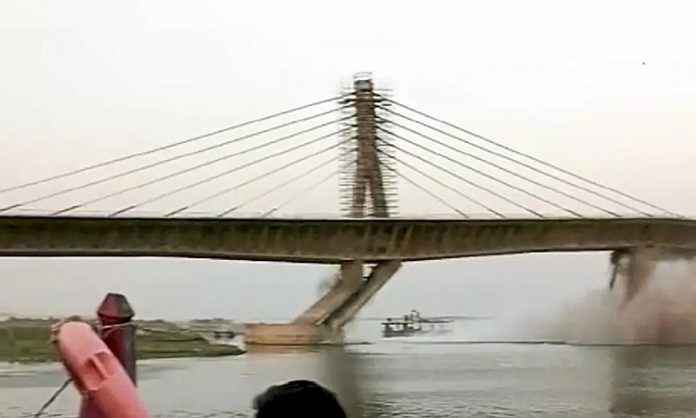Patna: Design of the ill-fated Aguanighat-Sultanganj bridge, which collapsed in the Ganga’s mainstream on June 4th, was vetted and approved by Indian Institute of Technology, Delhi (IIT-Delhi), the state road construction department (RCD) said in its reply to the Patna high court.
The RCD filed the affidavit in reply to a petition filed by Congress leader Lalan Kumar and two other persons in the high court. The petitioners have sought blacklisting of the construction company and judicial/CBI inquiry in to the bridge collapse. The court has conducted two hearing of the case, while August 12 has been fixed as the date for next hearing.
Also Read: Aguvanighat bridge on river Ganga in Bihar collapses, yet again
The experts of IIT-Roorkee, which was roped in by the RCD to study the failure of the bridge after first partial collapse on April 30th last year, attributed the collapse to ‘gross design failure.’ The experts in their report to the state government said that “the NDT (non-destructive test) of the entire span done by IIT-Roorkee also indicates some discrepancies in the bridge geometry…. The application of shims and unplanned wet stitches have been recommended by the designer. While it has been communicated regularly that these practices may have debilitating consequences on the structure, it has been maintained that the design is robust enough to incorporated these changes,” noted the IIT-Roorkee findings on bridge cave in.
The spans on pier 10-12 of the 3.16km long four-lane extradosed cable stayed bridge, being built by SP Singla Construction limited at the cost of ₹1710-crore, had caved in the mainstream of the river Ganga like pack of cards. The bridge was to connect Khagaria district in north and Bhagalpur in south. The IIT-Roorkee experts pointed out that nature of the first partial collapse on pier number 5 and those on other three piers was similar, for which the project designer, McElhanney Consultancy, Canada, was apprised about.
Also Read: Engineers shunted after Bihar bridge collapse get back key posts
The RCD engineers, however, argued that they were constrained to intervene as the construction company was building the project in engineering, procurement and construction (EPC) mode. The Bihar Rajya Pul Nirman Nigam Limited (BRPNNL) was confident about robustness of the design after the experts of the IIT-Delhi approved the drawing and design of the bridge as proof consultant. “Since the bridge construction is very specialised in nature (construction of cable stayed and extradosed bridge), that’s why experts from different countries and as well as from India were engaged as part of authority engineers,” read the counter affidavit of the RCD.
BRPNNL officials said that the preliminary report of the IIT-Roorkee experts had recommended for design review of the entire bridge portion and hence the design consultant was called to explain its various aspects on June 6, a day after the massive collapse. The IIT-Roorkee experts, comprising Mahesh Tandon and Vinay Gupta, had ruled out concrete weakness for the fall. “Segment 9 seems to be interface between right part and the flexible portion of the span. This could be the reason why the failure was triggered from this location,” they said.
Also Read: Police name Oreva group promoter in Morbi bridge collapse case
“As per our original conjecture, the root cause of both failures (on April 30, 2022 and June 4, 2023) seems primarily to be a failure of match casting. The failure is endemic as the segments in pier 5 and the segments that failure recently were cast in different casting yards on opposite sides of the river. In both the spans, unplanned wet stitches are commonly seen. Shims have also been applied regularly to overcome geometric differences due to match casting,” the experts’ report said.
The RCD in the counter-affidavit said that the additional chief secretary is conducting the inquiry and would submit its report within two months (by August 6). “In view of the complex nature of the project, it would be apt that the considered view is taken by the state government on consideration of entire materials,” the affidavit claimed.







